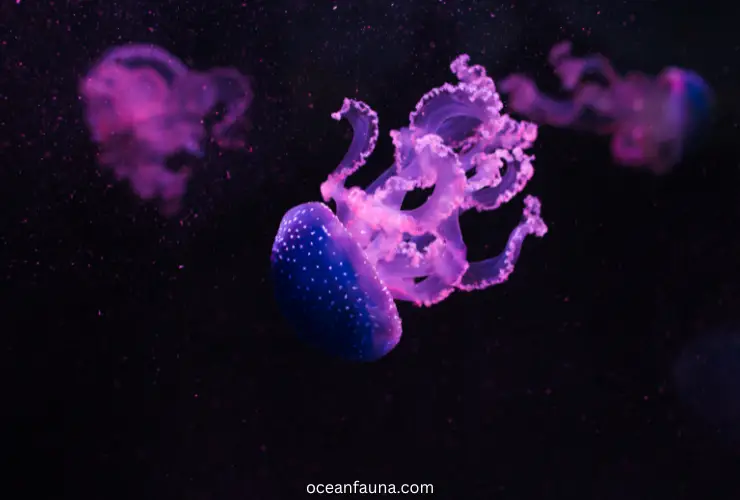Purple jellyfish is the only species in the genus Pelagia. Its family is the Pelagiidae. In English, it is known as a mauve stinger. This jellyfish has many common names, like night-light jellyfish, purple stinger, purple people eater, and luminous jellyfish.
The purple people eater is known as Pelagia noctiluca in Latin. Pelagia noctiluca means a marine organism that can glow (bioluminescent) when it is dark. These sea jelly species are found worldwide in warm and tropical temperate seas.
Have you ever wondered about the fascinating biography of purple jellyfish? What makes them so captivating and unique? If you are curious to know everything about them, you have come to the perfect place.
From their enchanting hues to their mesmerizing behaviors, we are going to explore everything here. So, get ready to be wowed by these stunning creatures.
About Purple Jellyfish – A Quick Biology
Here is a quick biology table about the enigmatic beauty of purple jellyfish for you! (Source)
| Parameters | Details |
| Scientific name | Pelagia Noctiluca |
| Kingdom | Animalia |
| Family | Pelagiidae |
| Genus | Pelagia (Péron & Lesueur, 1810) |
| Phylum | Cnidaria |
| Class | Scyphozoa |
| Order | Semaeostomeae |
| Species | P. noctiluca |
| Habitat | Pacific Ocean, North Atlantic Ocean, California, open oceans |
| Life Span | Up to one year |
| Diet / Food source | Zooplankton |
| Geographical range | Off the coast of California |
| Size | 3 to 12 centimeters |
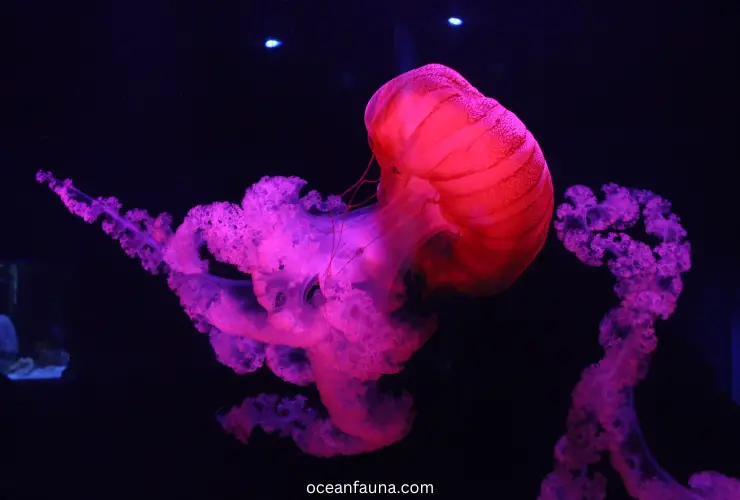
Description of Purple Jellyfish
Purple jellyfish is a strikingly beautiful sea jelly species with a purple hue. According to NCBI research, these sea jellies have tentacles and bells covered with stinging cells. This is an unusual characteristic among sea jellies.
Purple sea jellies are free-swimming marine animals. Their size ranges from just a few centimeters to a few meters in diameter. These are inhabitants of all oceans in the world, ranging from the Antarctic to the Arctic oceans.
Purple jellyfish are often seen floating near the surface of the water. Their bright purple color makes them stand out against the blue-green backdrop of the ocean. However, many people sometimes consider these a nuisance due to swarming behavior.
Bioluminescence of Purple Jellyfish
Purple jellyfish are known as bioluminescent. It means they have a unique and intriguing ability. They can produce low light. This is a special ability known as bioluminescence. This light can easily be seen with the human eye at night.
Moreover, purple jellyfish can emit light in the form of multiple flashes at a time. These are created after the stimulation of turbulence from the medusa. These are formed by the moment of a ship or waves.
The light flashing for a short period will fade away after that. Pliny the Elder mentioned “pulmo marinus” as a bioluminescent species in early times. It was described in Historia Naturalis (77 AD), which is now identified as Pelagia noctiluca.
Physical Characteristics of Purple Jellyfish
Purple jellyfish is one of the variably colored and a little bit smaller species of jellyfish. The diameter of their bells ranges from 3 centimeters to 12 centimeters. They have variable colors. The colors of the purple jellyfish may include the following:
- Mauve
- Purple
- Pink
- Light brown
- Yellow
More interstate, their bodies are in symmetrical shapes. Furthermore, they have the following body parts:
- One cavity part, commonly called the gastrovascular cavity, is used for excretion and ingestion purposes.
- Four oral arms that are long enough and used for feeding purposes.
- Eight long tentacles are used for catching prey.
Purple jellyfish have a unique structure with a manubrium that resembles a proboscis. They also have a relatively thick jelly-like mesoglea. Sense organs, called rhopalia, are located around the umbrella margin in notches and alternate between tentacles.
Cnidae, (stinging cells) are found in both the epidermis and gastrodermis of the umbrella as well as on the tentacles. Purple jellyfish have eight marginal tentacles with eight sense organs.
It’s four elongated endodermal proliferations that are developed into ribbon-like folds. These are located in the interradial sectors of the stomach wall.
These are slightly distal to the rows of gastric filaments. The gonads of both male and female species are similar. The follicle’s thickness is the main difference here. All these unique characteristics make them fascinating creatures of the waters.
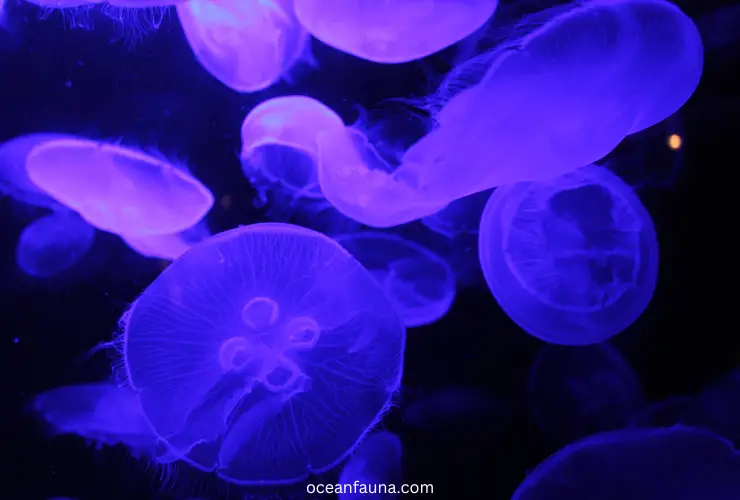
Diet / Feeding Habits of Purple Jellyfish
Purple jellyfish are known as opportunistic feeders. They feed on many various small organisms. Here is the list of small organisms that are included as a fiesta for purple jellyfish according to NCBI research: (source)
- Fish eggs
- Fish larvae
- Mollusk larvae
- Larvaceans
- Hydromedusae
- Siphonophorans
- Arrow worms
- Planktonic crustaceans
- Microscopic phytoplankton
- Comb jellies
Here, planktonic crustaceans include crustacean larvae, ostracods, copepods, and cladocerans. Detritus is also included in their dietary lifestyle, which is suspended in oceanic water. Cannibalism is also found in these species when adult purple jellyfish eat their own smaller species of purple jellyfish. (Source)
Purple jellyfish directly or indirectly eat the phytoplankton after eating herbivorous crustaceans. They fill their stomachs after them. This ability to eat phytoplankton is very unusual in the class of Cnidaria. Purple sea jellies consume copepods as their main source of food throughout the year.
Additionally, they also feed on fish eggs and pteropods. They mainly consume copepods and fish eggs during spring. Pteropods are consumed more frequently in December and May. So, they are considered to be generalists with no specific prey preference because they feed on many different foods.
Bozler (1926) observed purple jellyfish’s feeding behavior in research. He found that when food was presented to a tentacle, it quickly contracted towards the mouth. The food was then taken by the lip of an oral arm and transported slowly to the stomach.
Purple jellyfish are also known to feed on salps like Thalia democratica. But, they mainly feed by capturing food particles through the endoderm cells, making them suspension feeders. Their food preferences are not so choosy.
Behaviors of Purple Jellyfish
Here are a few innovative but fascinating behaviors of purple jellyfish:
- Movement: Purple jellyfish move by pulsating their bell-shaped body. They do this by propelling them forward in the water. They can also move vertically by changing the amount of water they take in or expel.
- Diurnal Migration: Purple jellyfish perform diurnal vertical migration. It means they move from the surface to deeper water during the day and back up to the surface at night. This behavior is thought to be a response to changing light and temperature conditions.
- Regeneration: Like many other jellyfish, Purple jellyfish have the ability to regenerate lost body parts. This means that if a tentacle or oral arm is damaged or lost, the jellyfish can grow it back over time.
Hope you like reading about the different behaviors of purple jellyfish. You can read their reproductive behaviors, spawning, and blooming behavior in the prior sections given in this article.
Distribution, Habitat, and Range of Purple Jellyfish
Purple jellyfish are distributed all over the world. These are commonly found in the region of the North Atlantic to the Atlantic Ocean. North of the equator is the range of its North Atlantic region, where it is abundantly available. The Gulf of Mexico and the Mediterranean are the areas of these inhabitants. (Source)
Purple jellyfish are also living in warm waters and tropical seas worldwide. There are many reports that state that these jellies are also present in the Indian Ocean and the Pacific Ocean. Purple jellyfish can be found as far south as the 42nd parallel. Some of the locations include:
- Australia – commonly found
- Hawaii – rarely found
- California – rarely found
Scientists suspect that the species Pelagia noctiluca may actually be a group of similar species that have not yet been identified. There are reports of related species outside the North Atlantic, but they have not been officially recognized or described. Interestingly, genetic analysis has revealed notable genetic differences between purple jellyfish in the North Atlantic and South Atlantic.
This shows that there may be distinct subpopulations within the species. A thorough review is required to understand the taxonomy of purple jellyfish fully. In 2014, a new species was identified in the Mediterranean, but it was later classified as Mawia benovici in its genus. (Source)
Habitat and Swarming behavior
Purple jellyfish are not strong swimmers, so they can sometimes end up inshore or on beaches. It can also appear in areas with temperatures outside its preference. These are mostly seen on the north side of the Norwegian deep and the Shetland Islands. (Source)
The species of purple jellyfish are typically found in waters with temperatures ranging from 10 to 27 °C, and it stops pulsating at temperatures below 11 °C. Pelagia noctiluca can be found at depths ranging from the surface to 1,400 m. It migrates vertically, swimming near the surface at night and deeper during the day. (Source)
Populations of purple jellyfish can vary widely and may not be seen in a region for years. However, they can suddenly reappear in massive swarms that cover large areas. These swarms can include millions of individuals and have densities of over 500 per m³. (Source)
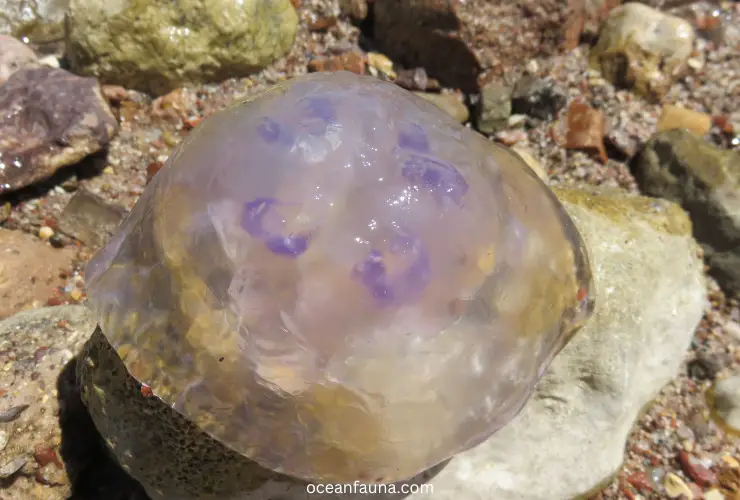
Life Cycle And Reproduction System of Purple Jellyfish
According to NCBI research, purple jellyfish live in the open sea and do not have a polyp stage, unlike most jellyfish. Other jellyfish have a life cycle including free-swimming and polyp stages. However, this species of sea jellies have adapted to a pelagic mode of life without the polyp stage.
Purple jellyfish reproduce sexually when males and females release sperm and eggs into the water during daylight hours. Fertilization occurs externally here. Fertilized eggs will be developed into planulae, which move through ciliary action. Planulae will become ephyrae with time (about one week).
These Planulae will become male or female medusae after a month. So, this is how male and female Planulae formed in the wild. Ephyra growth is very little or impossible sometimes at low temperatures. They do not survive at 10 °C. However, there are chances of survival at 8 °C.
Here the polyp stage should occur, but it does not occur here. It is because most jellyfish have a polyp stage between the planula and ephyra. As we have mentioned before, purple jellyfish do not have this stage.
Initially, their medusa only has a 1 cm diameter. They mature when their bell diameter reaches the length of 3.5 cm and are all mature at 6 cm.
Purple jellyfish primarily spawn in the Mediterranean Sea during late summer and early winter. However, they also spawn at lower levels in early summer and during spring. Purple jellyfish need good food conditions to spawn. When conditions are not ideal, the jellyfish will stop reproducing right away.
They will also lose weight if they don’t get enough food. Large groups of adult purple jellyfish can be found at the ocean surface during specific times of the year. These groups may be gathering to reproduce. Typically, these jellyfish live for approximately 6 to 9 months before they perish.
Cardiovascular And Nervous System of Purple Jellyfish
As we know that purple jellyfish are symmetrical in shape, so they have no centralized brain like humans and other animals. Although their centralized nervous system is missing, they still have a decentralized nervous system. It is said to be primitive because it has non-polar and nacked neurons.
The purple jellyfish also lacks a circulatory system. However, cnidae are always evolving due to Cnidaria. Cnidae are the cells that play numerous functions in the bodies of purple jellyfish. These functions may include:
- Attachment
- Locomotion
- Defense
- Prey Capture
Cnidae are known as cnidocytes when these are fully matured. The cnidae of purple jellyfish can release nematocyst toxins when triggered. According to the biological point of view, these toxins are poisonous and can be harmful to other marine organisms.
Predators of Purple Jellyfish
Purple jellyfish have their own set of predators just like other species of sea jellies. These predators are sometimes large and aggressive that eat purple jellies.
Here is a table that lists some of the known predators of these purplish creatures:
| Predators | Details |
| Sea turtles | Sea turtles are known as the main predators of purple jellyfish. |
| Ocean sunfish | These fish are often food on sea jellies, mostly purple jellyfish. |
| Sea birds | Various species of sea birds hunt and eat purple jellyfish. |
| Lion’s mane jelly | The larger lion’s mane jelly can prey on smaller jellies. |
| Butterfish | Butterfish have been observed feeding on purple jellyfish. |
Additionally, swordfish, Spiny dogfish, and many species of tuna and salmon are also predators of purple jellyfish.
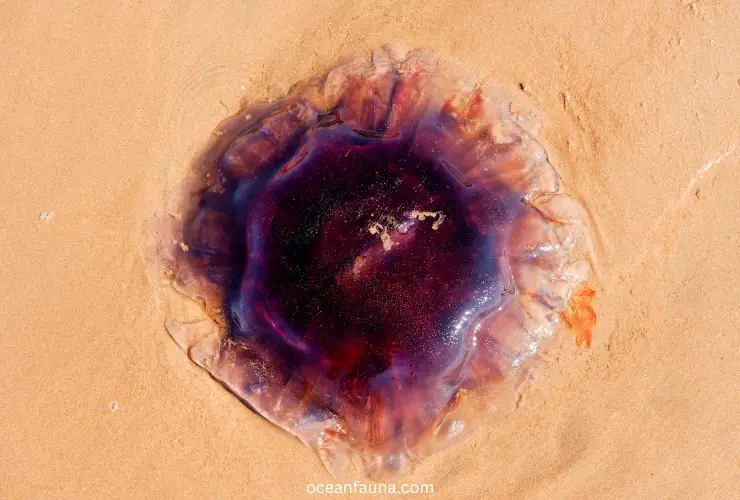
Relationship Between Purple Jellyfish And Humans
These wild creatures have a significant impact on humans. These are included as major tourist attractions for the locals and wildlife lovers. They are also a source of food for many marine animals.
However, they can also cause problems for humans. These jellyfish can cause skin irritation and even pain when stung. Additionally, the fishing industry can also be affected by large blooms of purple jellyfish. It is because they can damage fishing gear and impact the catch.
According to NCBI research, thousands of purple jellyfish washed ashore on various beaches all over the world. This bloom disturbs and affects the local economy. This is because tourists avoid visiting tourist places, especially beaches. Fishers, beachgoers, and divers are also stung mostly in this timespan.
Fishers are usually stung when they try to bring their nets out of water. Their nets get clogged by the purple jellyfish. Thus, this proliferation poses a serious problem for fishermen. However, this is the only complex and complicated relationship between purple jellyfish and humans.
Additionally, we are now going to disclose a crazy and shocking fact here. The swarms of purple jellyfish have the ability to wipe out the complete farms of fish. There are many recorded incidents of this creepy fact. Due to this behavior, the purple jellyfish is also one of the most studied sea jellies. (Source)
Amazing Fun Facts about Purple Jellyfish
Here are a few fun facts about purple jellyfish that will surprise you:
- Purple jellyfish do not have bones, an excretory system, and a gaseous exchange system like other animals.
- They are able to shrink and expand their body size in response to changes in temperature and salinity.
- They are capable of reversing their swimming direction by using their bell.
- They can be bred in captivity for scientific purposes.
- Their body is composed of up to 95% water.
- Purple jellyfish have a symbiotic relationship with certain species of crabs.
- Some of the purple jellyfish trap their prey, hunt them, and eat them while others crawl to trap their prey.
- The complete lifecycle of the purple-striped jellyfish was first discovered at the Monterey Bay Aquarium.
Can a Purple Jellyfish Sting Hurt You?
Yes. The sting of a purple jellyfish can hurt you. Their sting is described as mild to moderate. These sea jellies are commonly referred to as the most common stinging jellies of the Mediterranean Sea.
The severity of the sting depends on several factors, including the following: (source)
- size of the jellyfish
- amount of venom injected
- sensitivity of the individual who was stung
Their sting is as mild as most people receive even without any medication. However, it is important to seek medical assistance if a person is allergic and in pain.
According to NCBI research, stinging incidents from purple jellyfish are common. Their stings are painful and can leave severe symptoms. The symptoms take considerable time to fade. However, these are not dangerous. (Source)
Purple jellyfish have four stinging types of different nematocysts. Only two of them are used for stinging purposes. These two nematocysts include eurytele and O-isorhiza. Their sting cause minor pain that lasts only a few days. There are no known fatalities due to the sting of these aquatic animals.
Purple jellyfish sting effects:
Here are a few other effects of purple jellyfish sting:
- Dizziness
- Diarrhea
- Vomiting
- Swelling
- Local redness
- Allergic reaction
- Hyperpigmentation
There exists a singular recorded instance in which a sting from Purple jellyfish resulted in Guillain-Barré syndrome. However, all other indications resolved within a period of six months.
What to Do If Get Stung by a Purple Jellyfish?
Here is what to do if you get stung by a purple jellyfish:
- Rinse the affected area with vinegar to neutralize the stinging cells.
- Remove any tentacles that may be stuck to the skin using tweezers or gloves.
- Soak the affected area in hot water for 20-45 minutes to relieve pain.
- Take pain medication and apply topical creams to relieve itching.
- Seek medical attention if the sting is severe or if symptoms persist.
Here is how to avoid purple jellyfish stings:
- Avoid swimming in areas where purple jellyfish are known to be present.
- Wear protective clothing, such as a wetsuit or dive skin.
- Stay alert and avoid touching or swimming near any jellyfish.
- Swim with a buddy who can help in case of an emergency.
- Follow beach warnings and advisories and heed lifeguard instructions.
Are Purple Jellyfish Endangered?
No. Purple jellyfish are not endangered. Sometimes these are found abundantly on the shores and beaches in the form of blooms. However, their population fluctuates due to environmental factors such as temperature, pollution, and overfishing. Their population status or conservation status is unknown.
Rare Mauve Stinger Jellyfish Spotted at the Jersey Shore
According to the news, the Mauve Stinger Jellyfish, which is rarely seen along the Jersey Shore, was recently spotted in the waters off Manasquan. But it was a rare species of jellyfish with unique characteristics.
Its tentacles were 9 feet long. Wildlife experts are saying that you should inform them if you ever encounter these purplish species of sea jellies because these are poisonous and possess a powerful venom. (Source)
FAQs
Are purple jellyfish poisonous?
Yes. Purple jellyfish are poisonous and toxic jellyfish. However, their venom is not considered capable of killing a big animal or a human. Still, stay away from these sea jellies to avoid any complications.
How painful is a mauve stinger?
The sting of a mauve stinger has been reported to be quite painful. Some people describe it as feeling like a shock from a 9-volt battery. It is said to be more painful than the sting of a typical jellyfish. So, do not close with these sea jellies.
What are the big purple jellyfish in Florida?
The moon jellyfish is known as the big purple jellyfish in Florida. It is found all over the world. You can recognize it easily with its four circles known as gonads present at its stomach’s bottom. These are purple. (Source)
Can you eat purple jellyfish?
There is no evidence available that eating purple jellyfish is beneficial. These are not deadly creatures but still eating these sea creatures can be dangerous for health.
Proper research is needed on this topic as humans do not consume these. Therefore, eating purple jellyfish or any other type of jellyfish is not recommended without proper research.
Can you keep purple jellyfish as pets?
Yes, it is possible to keep purple jellyfish as pets. But, it requires a specialized aquarium and careful maintenance. It is important to note that jellyfish are delicate creatures and not suitable for inexperienced pet owners.
Conclusion
It was such a pleasure to write about the purple jellyfish’s biography. These mysterious species of jellyfish will continue to intrigue us in the future too. There is always something new to learn about these sea jellies. Thanks for joining our journey about mauve stinger.
So, stay in touch with us. We will update you with more amazingly interesting information about these marine animals.

